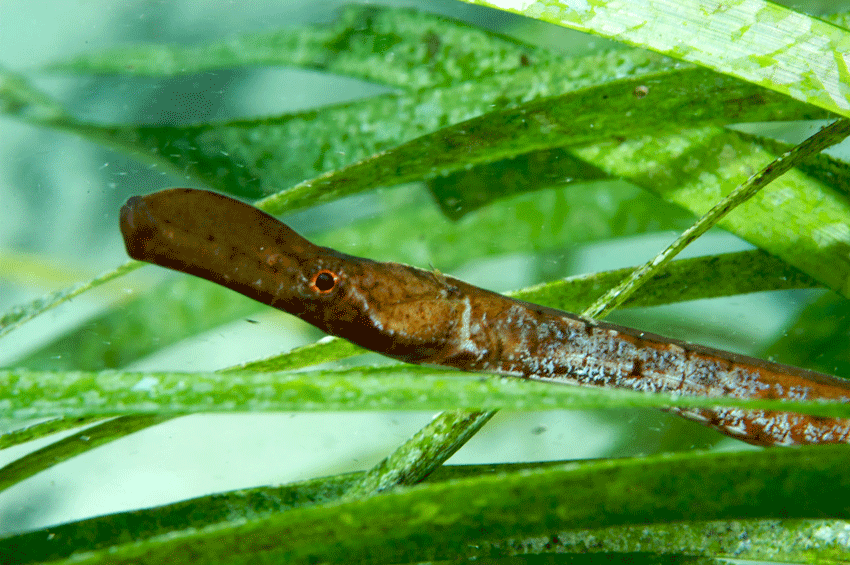Crested Pipefish, Histiogamphelus briggsii McCulloch 1914

A Crested Pipefish, Histiogamphelus briggsii, amongst seagrass leaves at Normanville, Gulf St Vincent, South Australia. Source: Graham Short. License: CC BY Attribution-Noncommercial-ShareAlike
A well-camouflaged pipefish that resembles decaying or encrusted seagrass leaves, algae and detritus. The high rounded snout ridge that only extends to the area between the eyes is distinctive.
Crested Pipefish usually inhabit sandy areas, seagrass or algal beds. They also shelter amongst decaying leaves of the eelgrass Posidonia.
Crested Pipefish, Histiogamphelus briggsii McCulloch 1914
More Info
|
Distribution |
Endemic to south-eastern Australia, from Seal Rocks, New South Wales, south to Victoria and northern Tasmania, to Yorke Peninsula, Spencer Gulf, South Australia. A beach-washed specimen was found on Grants Beach, north of Laurieton, New South Wales. Crested Pipefish inhabit inshore sandy areas, singly or in small aggregations, often amongst detached seaweed or along the margins of Posidonia and Zostera seagrass beds, at depths to 30 m. |
|
Features |
Dorsal fin 24-28; Anal fin 3-4; Pectoral fin 11-14; Caudal fin 10; Trunk rings 20-22; Tail rings 33-37; Subdorsal rings 5.50-4.00 + 2.00-3.50 = 6.75-8.25. Body elongated, trunk shallow; head aligned with body; snout moderately long, 38-56% head length; snout depth 37-59% snout length; median dorsal snout ridge high and plate-like, rounded or emarginated; females deeper bodied than males; superior trunk and tail ridges discontinuous near rear of dorsal-fin base; lateral trunk ridge not confluent with tail ridges; tail not prehensile. Dorsal fin centred on back with base of moderate length, closer to head than to tip of tail; anal fin tiny, below rear half of dorsal fin; caudal fin very small, rounded in sub-adults to adults, large in small juveniles; pectoral fin present. |
|
Size |
Maximum length 25 cm |
|
Colour |
Females are mainly tan to dark brown with small, irregularly arranged, brown spots and dark-margined ocelli on side of trunk and anterior part of tail. Males are plain brown or with irregular pale streaks and blotches on side. |
|
Feeding |
Feeds on tiny mysid shrimps and other small crustaceans living on debris on sandy habitats. |
|
Biology |
Male Crested Pipefish (12cm and larger) brood the developing young in a brood pouch under the tail just behind the anal fin. Pouch folds are present and the pouch closure is everted. Eggs and larvae have not been described. |
|
Fisheries |
Of no interest to fisheries or aquaculture. |
|
Conservation |
EPBC Act 1999: Marine listed Listed as protected under the New South Wales, Victorian, Tasmanian and South Australian Fisheries Management Acts |
|
Remarks |
During summer, individual Crested Pipefish gather in large numbers in some areas off beaches in central New South Wales. |
|
Similar Species |
Crested Pipefish are most similar to the Rhino Pipefish, Histiogamphelus cristatus, the only other member of the genus. Although both have the characteristic high snout ridge, the dorsal snout ridge of H. briggsii does not extend beyond the interorbit, and the Crested Pipefish has more tail rings (33-37) than the Rhino Pipefish (28-31). |
|
Etymology |
The specific name is from the Greek gamphelai (= jawbone), in reference to the crest on the snout. |
|
Species Citation |
Histiogamphelus briggsii McCulloch 1914, Aust. Zool. 1(1): 29-31. Type locality: Wineglass Bay, east coast of Tasmania. |
|
Author |
Bray, D.J. & Thompson, V.J. 2021 |
|
Resources |
Crested Pipefish, Histiogamphelus briggsii McCulloch 1914
References
Dawson, C.E. 1984. Synopsis of Australian pipefishes usually referred to the syngnathine (tail-pouch) genera Syngnathus, Leptonotus and Histogamphelus. Memoirs of Museum Victoria 45: 71-123
Dawson, C.E. 1985. Indo-Pacific Pipefishes (Red Sea to the Americas). Ocean Springs (Mississippi) : Gulf Coast Research Laboratory 230 pp. 293 figs pl. 1.
Dawson, C.E. 1994. Family Syngnathidae. pp. 440-475 figs 391-426 in Gomon, M.F., Glover, C.J.M. & Kuiter, R.H. (eds). The Fishes of Australia's South Coast. Adelaide : State Printer 992 pp. 810 figs.
Kendrick, A.J. & Hyndes, G.A. 2005. Variations in the dietary compositions of morphologically diverse syngnathid fishes. Environmental Biology of Fishes 72: 415-427.
Kuiter, R.H. 1993. Coastal Fishes of South-eastern Australia. Bathurst : Crawford House Press 437 pp.
Kuiter, R.H. 2000. Seahorses, Pipefishes and Their Relatives. Chorleywood, UK : TMC Publishing 240 pp.
Kuiter, R.H. 2008. Syngnathidae. pp. 448-479 in Gomon, M.F., Bray, D.J. & Kuiter, R.H. (eds). Fishes of Australia's Southern Coast. Sydney : Reed New Holland 928 pp.
Kuiter, R.H. 2009. Seahorses and their relatives. Seaford, Australia : Aquatic Photographics 331 pp.
Last, P.R., Scott, E.O.G. & Talbot, F.H. 1983. Fishes of Tasmania. Hobart : Tasmanian Fisheries Development Authority 563 pp. figs.
McCulloch, A.R. 1914. Notes on some Australian pipefishes. The Australian Zoologist 1(1): 29-31 figs 1-4
Pollom, R. 2016. Histiogamphelus briggsii . The IUCN Red List of Threatened Species 2016: e.T65368238A67622405. https://dx.doi.org/10.2305/IUCN.UK.2016-1.RLTS.T65368238A67622405.en. Downloaded on 12 November 2019.
Scott, T.D., Glover, C.J.M. & Southcott, R.V. 1974. The Marine and Freshwater Fishes of South Australia. Adelaide : Government Printer 392 pp. figs.
Whitley, G.P. 1948. Studies in Ichthyology No. 13. Records of the Australian Museum 22(1): 70-94 figs 1-11 https://doi.org/10.3853/j.0067-1975.22.1948.592, (described as Histiogamphelus maculatus robensis)
Whitley, G.P. 1950. Studies in Ichthyology No. 14. Records of the Australian Museum 22(3): 234-245 figs 1-5 pl. 17 https://doi.org/10.3853/j.0067-1975.22.1950.604, (described as Histiogamphelus briggsii orae)










